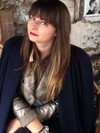"Burkini" has never been such a loaded word or the subject of such fervent debate in the West as it is right now. This lightweight swimsuit, which covers every part of the body but the face, hands, and feet, is (depending on who you talk to) a symbol of either freedom or oppression, a sign that an Islamic fundamentalist takeover is either imminent or has collapsed irrevocably. This is what happens when women try to enjoy a quick dip without compromising their religious beliefs.
Advertisement
To photographer Melina Papageorgiou, the burkini is a swimsuit, and the Burkini series is an invitation for outside observers to look at the materiality of the thing without being poked or prodded towards political interpretation or harmful stereotyping.Papageorgiou, who is of German and Greek extraction, spent most of her formative years in northern Greece, near Athens. Her father was an engineer, so they spent extended periods of time in different countries. She lived for a period in Gaddafi-controlled Libya, where she saw a woman bathing in her clothes for the first time. "Somehow I was really confused, because my mother was wearing only a swimsuit. [I thought] why are they doing that? I don't remember what my parents told me that time."
Her parents now live in Abu Dhabi and Papageorgiou, who is currently studying photography in Berlin, visits them often. It was there that she saw women swimming in burkinis. Originally designed in Australia by Aheeda Zanetti, the burkini is named as a portmanteau of "burqa" and "bikini"—polar opposites on the modesty scale. In an interview with the Sydney Morning-Herald, Zanetti said of the word "burkini": "It's just a name that I invented. It doesn't mean anything. It's really an Islamic two-piece bikini, but that sounds stupid."**Read more: How Islamophobia Hurts *Muslim* Women the Most**
All photos by Melina Papageorgiou
"When I saw the burkini then, in Abu Dhabi, I got totally excited, seeing that they created a swimsuit for women to be able to take part in sports for practical reasons, just finding their way to make them feel more comfortable," says Papageorgiou. She started collaborating with women at local pools. Many of them were reluctant to show their faces, with the exception of one. "I photographed a teenager and she was more open. I asked if it was OK to show her face and she was like, 'Yeah, no problem.' I think it's logical; the new generation are more open to new things and travelling more, so they're meeting many international people. Abu Dhabi is really international, that makes it interesting."
Advertisement
However, burkinis are not the sole focus of Burkini. Burkini is a meditation on life in Abu Dhabi from the point of view of an expatriate. "Burkinis were a base, but I was trying to see the big picture. How people live there. It's really important to say that I'm an outsider. I have travelled there many, many times, but I am still an outsider. I didn't grow up in this culture. [Burkini] is just a way of observing. That's an important point, that I'm an outsider."
The closely-shot images are detail-oriented and have a diaristic feel. Many were taken in and around cars or from moving vehicles. "I was also really interested in finding colours and shapes and form. Those were also things that I was looking for in the images," she says. The closeness of the shots allude to a laser-focused abstraction, where fabric floating through water becomes a study in movement, where car windows become frames for distant skyscrapers. "It was very important for me to take the images really close, because one thing I wanted understood was that so… well, the burkini is, in a way, just a fabric. A car is just a car. It was important to photograph them really close—visually really close—just to observe it as it is.
Papageorgiou doesn't ignore the contradictions inherent in conversations about burkinis, but neither did she design this series to make a moralistic statement. "OK, the burkini can be translated in political terms—or as an object of freedom, because women can play sports. Or it's the opposite; they're losing their freedom because they're hidden, they have to be covered and sometimes it doesn't look so comfortable."
Advertisement
"The things that people translate—I was more interested to look as it as it as," she continues. "And that's why it was important for me to photograph them really close, to not show the surroundings or what is happening around it to make a story, a drama. I wanted to show exactly to the point what I'm thinking about, not to give food to people to judge by imagining the possibilities of the situation. To just show that it exists, that the burkini exists and that people exist and to leave that more open. Showing clearly that I am an outsider."
"That's the point. I may have a strong opinion in some things, but in our time I feel that we need to make more decisions [carefully]. Also the younger people generally; we get so much information and, in a way, we lose the balance of making decisions. What women or people generally decide to wear and why they wear things. That's also about making decisions, so it's a point I wanted to make. To leave it more open."
"Everybody should make a decision for themselves, in a way of freedom. Everybody should work on themselves to be responsible for their way of living or being or acting."
